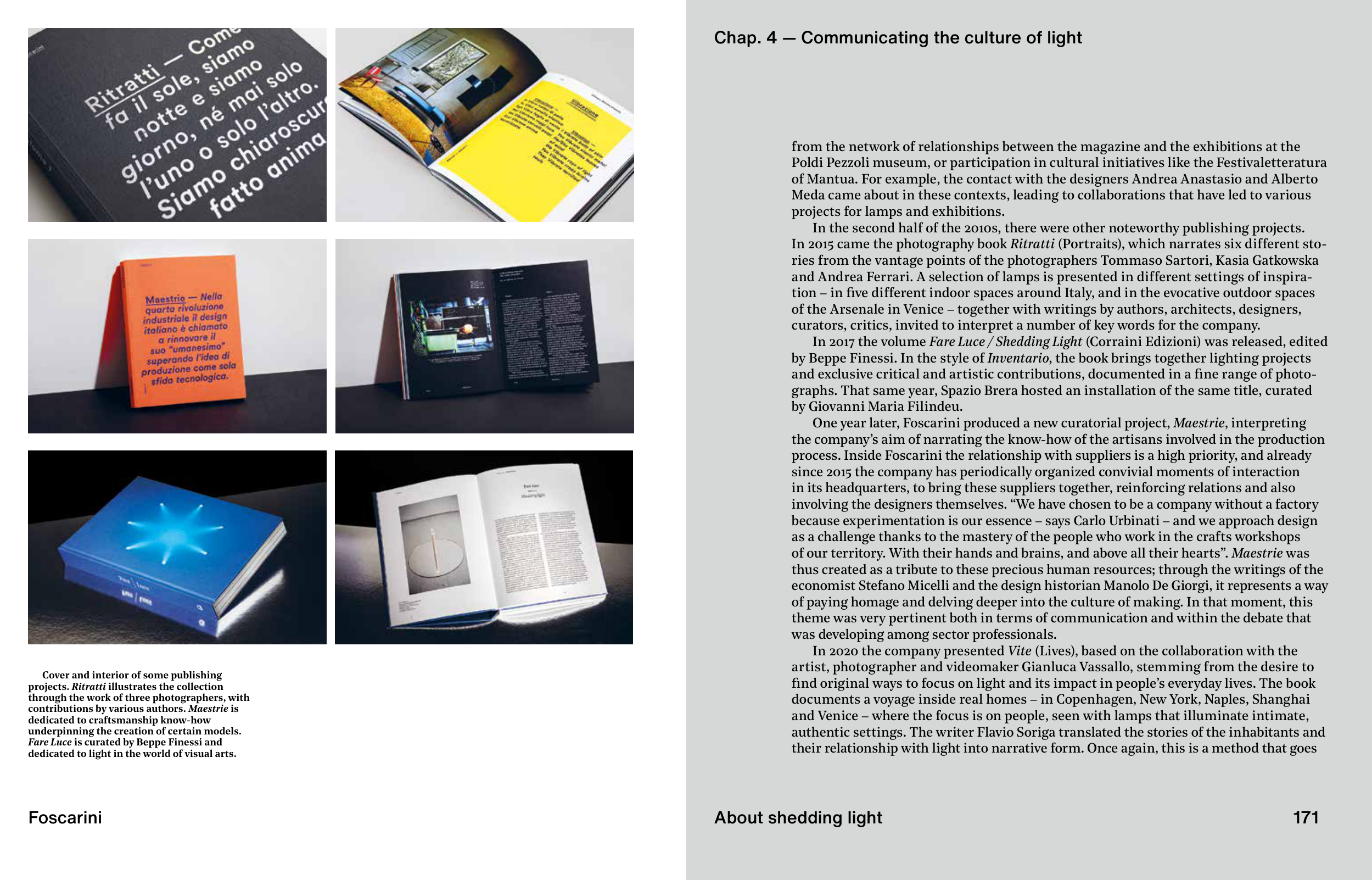Foscarini
171
Cover and interior of some publishing
projects. Ritratti illustrates the collection
through the work of three photographers, with
contributions by various authors. Maestrie is
dedicated to craftsmanship know-how
underpinning the creation of certain models.
Fare Luce is curated by Beppe Finessi and
dedicated to light in the world of visual arts.
About shedding light
Chap. 4 — Communicating the culture of light
from the network of relationships between the magazine and the exhibitions at the
Poldi Pezzoli museum, or participation in cultural initiatives like the Festivaletteratura
of Mantua. For example, the contact with the designers Andrea Anastasio and Alberto
Meda came about in these contexts, leading to collaborations that have led to various
projects for lamps and exhibitions.
In the second half of the 2010s, there were other noteworthy publishing projects.
In 2015 came the photography book Ritratti (Portraits), which narrates six different sto-
ries from the vantage points of the photographers Tommaso Sartori, Kasia Gatkowska
and Andrea Ferrari. A selection of lamps is presented in different settings of inspira-
tion – in fi ve different indoor spaces around Italy, and in the evocative outdoor spaces
of the Arsenale in Venice – together with writings by authors, architects, designers,
curators, critics, invited to interpret a number of key words for the company.
In 2017 the volume Fare Luce / Shedding Light (Corraini Edizioni) was released, edited
by Beppe Finessi. In the style of Inventario, the book brings together lighting projects
and exclusive critical and artistic contributions, documented in a fi ne range of photo-
graphs. That same year, Spazio Brera hosted an installation of the same title, curated
by Giovanni Maria Filindeu.
One year later, Foscarini produced a new curatorial project, Maestrie, interpreting
the company’s aim of narrating the know-how of the artisans involved in the production
process. Inside Foscarini the relationship with suppliers is a high priority, and already
since 2015 the company has periodically organized convivial moments of interaction
in its headquarters, to bring these suppliers together, reinforcing relations and also
involving the designers themselves. “We have chosen to be a company without a factory
because experimentation is our essence – says Carlo Urbinati – and we approach design
as a challenge thanks to the mastery of the people who work in the crafts workshops
of our territory. With their hands and brains, and above all their hearts”. Maestrie was
thus created as a tribute to these precious human resources; through the writings of the
economist Stefano Micelli and the design historian Manolo De Giorgi, it represents a way
of paying homage and delving deeper into the culture of making. In that moment, this
theme was very pertinent both in terms of communication and within the debate that
was developing among sector professionals.
In 2020 the company presented Vite (Lives), based on the collaboration with the
artist, photographer and videomaker Gianluca Vassallo, stemming from the desire to
fi nd original ways to focus on light and its impact in people’s everyday lives. The book
documents a voyage inside real homes – in Copenhagen, New York, Naples, Shanghai
and Venice – where the focus is on people, seen with lamps that illuminate intimate,
authentic settings. The writer Flavio Soriga translated the stories of the inhabitants and
their relationship with light into narrative form. Once again, this is a method that goes
171


